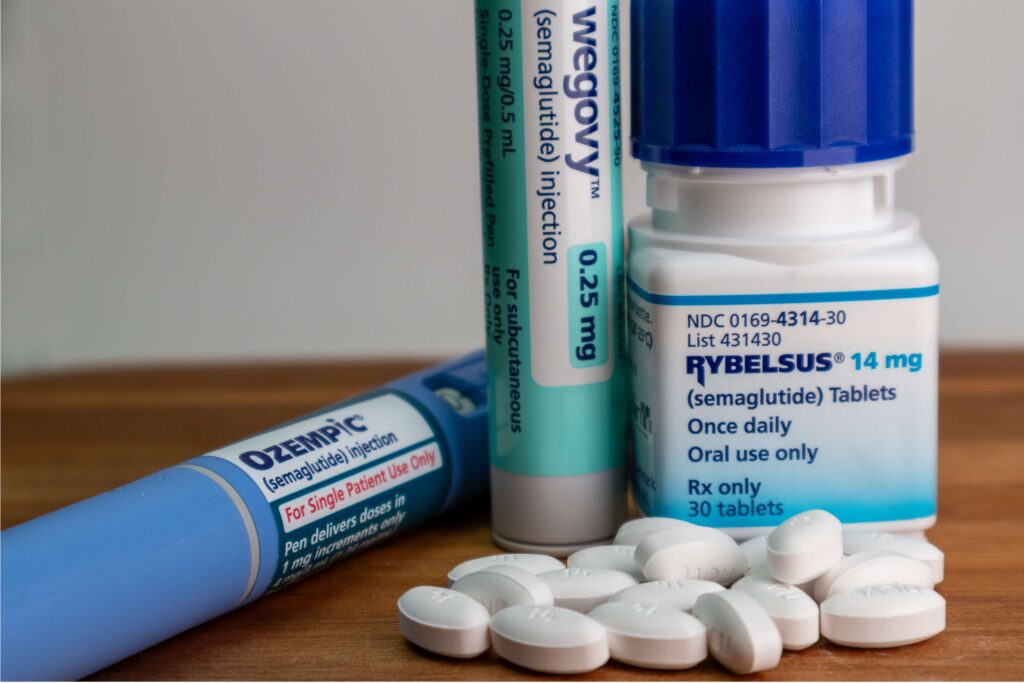Ozempic and Alcohol: What You Should Know
Moderate alcohol use is generally permissible while on Demaglutide (Ozempic®/Wegovy®) or Tirzepatide (Mounjaro®, Zepbound®), though extra caution is wise due to blood-sugar variability and compounded GI side-effects.
As for craving control, semaglutide—and potentially tirzepatide—shows promising but preliminary evidence of reducing alcohol consumption. Larger Phase III trials are under way, and FDA approval would be the next milestone. Overland IOP continues to monitor the science so clients can make evidence-based decisions about incorporating GLP-1 medications into comprehensive recovery plans.

Can You Drink While Taking Ozempic?
Short answer: usually yes, but with caution. Neither the FDA label nor major drug references list a direct interaction between semaglutide (Ozempic®/Wegovy®) and alcohol. Still, two practical risks matter:
- Blood-sugar swings. Alcohol can drive glucose sharply up or down; pairing it with a GLP-1 drug may raise the chance of hypoglycemia, especially for people with type 2 diabetes or anyone using insulin/sulfonylureas.
- Worsened side-effects. Semaglutide already slows stomach emptying and can cause nausea. Alcohol magnifies those GI symptoms.
Most endocrinologists advise sticking to moderate drinking and avoiding alcohol on days when semaglutide side-effects are strong. Always check your own glucose more often the first few times you combine the two.
Does Ozempic Actually Reduce Alcohol Cravings?
Early data say “maybe.”
- Human pilot trial. In 2025 a double-blind JAMA Psychiatry study gave low-dose semaglutide to 48 adults with Alcohol Use Disorder (AUD). Participants on the drug cut total drinks about 40 percent and reported significantly lower craving scores than those on placebo.
- Real-world records. A Nature analysis of 83,000 electronic-health-record profiles found both semaglutide and the newer dual agonist tirzepatide were linked to fewer binge-drinking episodes and lower odds of developing AUD over 12 months.
- Pre-clinical support. Multiple rodent studies show semaglutide and tirzepatide blunt alcohol- and opioid-seeking without sedating the animals. niaaa.nih.govjamanetwork.com
Important caveat: No GLP-1 drug—semaglutide, tirzepatide, or the next-gen “tri-agonists”—is FDA-approved for treating alcohol or opioid use disorder. All current prescribing for cravings is off-label and experimental.

How Do Tirzepatides Fit Into the Picture?
Tirzepatide (Mounjaro®, Zepbound®) targets both GIP and GLP-1 receptors and outperforms semaglutide for weight-loss. Early EHR data suggest it lowers alcohol intake to a similar—or possibly greater—extent. A first-in-human tirzepatide-for-AUD trial (NCT07046819) is now recruiting; results are expected in late 2026. Until then, any craving benefit remains unsupported.
Practical Guidance
- Moderation first. If you choose to drink on Ozempic or tirzepatide, stay within low-risk limits and monitor blood sugar closely.
- Adjunct—not replacement. Even if cravings drop, GLP-1 drugs don’t replace counseling, medication-assisted treatment, or peer support.
- Off-label realities. Insurers rarely cover semaglutide or tirzepatide for addiction alone; out-of-pocket costs can exceed $1,000/month.
- Medical screening. History of pancreatitis, severe GI disease, or eating disorders may preclude GLP-1 therapy. Review risks with a qualified clinician.


Moderate alcohol use is generally permissible while on Ozempic, though extra caution is wise due to blood-sugar variability and compounded GI side-effects. As for craving control, semaglutide—and potentially tirzepatide—shows promising but preliminary evidence of reducing alcohol consumption. Larger Phase III trials are under way, and FDA approval would be the next milestone. Overland IOP continues to monitor the science so clients can make evidence-based decisions about incorporating GLP-1 medications into comprehensive recovery plans.
Published: June 06, 2025
Last Updated: July 09, 2025

Published: December 15, 2025
Behavioral Health During the Holidays: Managing Stress, Anxiety & Emotional Triggers
Why the Holidays Are Harder Than They Look? For many people, the holiday season is portrayed as joyful and restorative. In reality, December is one of the most emotionally challenging months of the year, especially for individuals navigating mental health conditions, substance use recovery, or emotional regulation difficulties. According to the National Alliance on Mental […]
Read more
Published: December 12, 2025
Identity Disorders (DID): When Sense of Self Becomes Unstable
A stable sense of identity helps people understand who they are, how they relate to others, and what gives their life meaning. When identity becomes fragmented, unstable, or unclear, it can significantly affect emotional well-being, relationships, and recovery from mental health or substance use disorders. Identity-related disorders are complex and often misunderstood. At Overland IOP, […]
Read more
Published: November 28, 2025
What Causes Seasonal Affective Disorder?
Seasonal Affective Disorder (SAD) is not simply a reaction to colder weather or shorter days. It is a form of depression influenced by biological, environmental, and psychological factors that interact with seasonal changes. Understanding what causes SAD can help individuals recognize symptoms early and seek effective treatment. According to the National Institute of Mental Health […]
Read more
